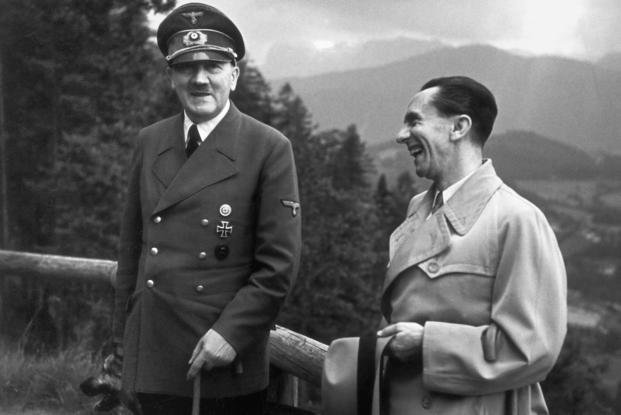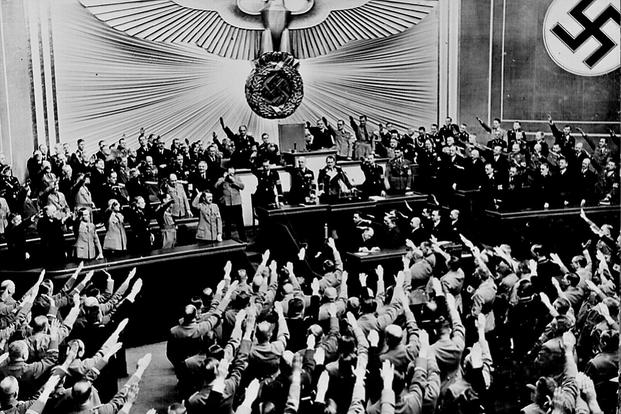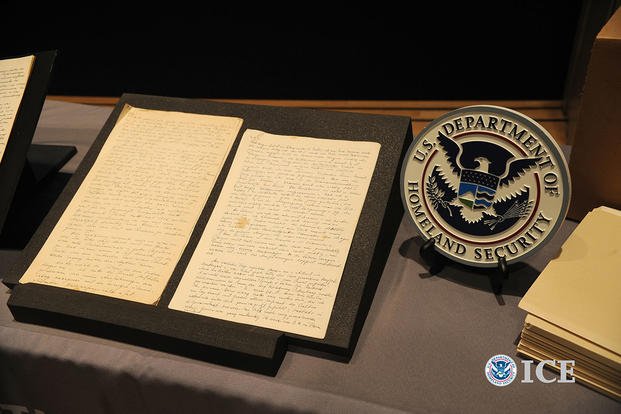World War II ended in 1945. Historians have produced voluminous writings to chronicle its course. But among the mysteries that still remain is this question: How did Adolf Hitler die? And did he actually die in his bunker?
Even now, considerable material remains classified about wartime military and intelligence operations.
Some conspiracy theories claim that Hitler, Germany's dictator, did not actually die in his Berlin bunker in 1945 but escaped and found refuge in South America. The theme that Hitler lived has fueled countless movie scripts and thrillers, plus several "documentaries."

British historian Hugh Trevor-Roper documented the official account of the death of Hitler in his book, "The Last Days of Hitler." A British intelligence officer during the war, Trevor-Roper was tasked in June 1945 with documenting Hitler's last days to prove the evil leader had in fact died in his bunker.
Read More: 'Burial' Tells a Fictional WWII Story About What Happened to Hitler's Body
An Odd Choice for a Hitler Historian
Critics of his book have argued that Trevor-Roper was an odd choice for the job. Though he went on to become a distinguished military historian and the Regius professor of modern history at the University of Oxford from 1957 to 1980, Trevor-Roper was known in 1945 as a specialist in 16th- and 17th-century British history. He neither spoke nor read German. He completed his research over 10 days. He appears to have relied on summaries of interrogations of people thought to have been in the bunker with Hitler in the last week of April 1945. American intelligence officers provided those summaries. He did not have access to Nazi prisoners being held by the Soviets, and it is unclear whether he spoke to any of the alleged witnesses.
Eyewitness testimony was contradictory, claiming Hitler's death had occurred on any one of five days between April 27 and May 1. Accounts of the cause of death ranged from natural causes to poisoning to suicide. There was a consensus that the body of Hitler had been burned, but the descriptions of the body and how it was dressed varied considerably.
It is common for eyewitness descriptions to vary widely, as police investigators know. It does appear, however, that Trevor-Roper constructed a narrative of Hitler's death by combining the various eyewitness accounts.
One might assume, if there were any chance Hitler escaped from Berlin, Western Allies would have eagerly publicized it and organized the world's greatest manhunt. In fact, it was in the Allies' interest to advance the narrative Hitler killed himself in the bunker. The Allies believed Germans would accept the occupation more readily if they believed Hitler was dead and that the prospect of a Hitler-led Nazi resurgence was impossible.
Moreover, the Allies were determined to show Hitler had died a coward's death. They wanted to erase any chance that the Nazis could advance a repeat of the "stabbed in the back" explanation that followed Germany's defeat in World War I.
Trevor-Roper's task was not to determine what happened in Hitler's final days. It was to put together an argument that he had died in the bunker. This he did, creating a bestseller in the process.
Read More: How a WWII British Op Fooled Hitler and Ensured a Successful Invasion of Sicily
Operation Sunrise
There was another reason the Allies wanted Hitler dead: Operation Sunrise.
Hitler's alpine retreat in Bavaria, Berchtesgaden, was more than just der Führer's vacation hideaway. All the major figures in the Nazi government had homes in Berchtesgaden, in some cases as annexes to Hitler's palatial estate. Miles of tunnels were built into the mountain below Hitler's Eagle's Nest, including a 240,000-square-foot command center.
The Nazis had intended, after the fall of Berlin, to continue the war from their mountain fortress in Bavaria. Significantly, the Allies captured Hermann Goering, along with scores of other Nazi party bigwigs, in Bavaria. After the war, the German government destroyed what was left of Berchtesgaden, bulldozing the debris and planting trees over the site to ensure it did not become a shrine to Hitler. The tunnels and the underground bunker were sealed, but presumably still exist.

In March 1945, with the end of the war in sight, the Office of Strategic Services (OSS), with the assistance of Swiss intelligence operatives, began a series of negotiations.
Dubbed Operation Sunrise -- otherwise known as Operation Sunrise-Crossroads or Crossword -- these talks took place between Allen Dulles (the first civilian director of Central Intelligence) and Waffen-SS General Karl Wolff over the surrender of Army Group C in northern Italy and western Austria.
Army Group C was tasked with the defense of northern Italy. It consisted of about 1 million Wehrmacht soldiers, most of whom were being held in reserve. But Army Group C was also responsible for manning the Nazis' Alpine redoubt.
There are several extensive histories of Operation Sunrise. There are also a lot of unanswered questions. The OSS files regarding the negotiations ended up at the CIA, and it is not clear whether they have all been released. Wolff was not authorized to conduct negotiations with the Allies. The surrender of Army Group C on May 2, five days before Germany's official surrender, sealed the fate of the Third Reich and eliminated any possibility of continuing the war in the Bavarian Alps.
Read More: Hitler's Aborted Last Stand: WWII's Unexpected Ending
Fueling Conspiracy Theories
This is where the conspiracy theories have taken root. One version says Wolff convinced Hitler that he was negotiating an anti-Soviet alliance with the Western Allies. This deal would supposedly cease hostilities on the Western Front and let Allied armies and the remaining German forces immediately advance east and stop any further Soviet advances.
Such an explanation isn't that far-fetched. Hitler harbored fantasies until his death that he could create a split between the Soviets and the Western Allies.
A related version of the story is that, as part of this new alliance, Hitler would be given safe passage out of Germany. That addendum might have come from Wolff or have been created by the Soviets. Available Allied records of the negotiations say nothing about such a deal.
Another version of the story is that Hitler proposed a potential alliance with both the Soviets and the Western Allies, offering the remaining German military forces to whichever side agreed first. The combined force would then push either the Western Allies or the Soviets out of the European territory they controlled.
This would have been a replay of the negotiations between the Nazis and the British and French on one side and the Soviets on the other side, which ultimately led to the Molotov-Ribbentrop Pact in 1939, a nonaggression pact that divided eastern Europe into German and Soviet spheres of influence.
That Hitler thought such a scenario plausible isn't surprising, but there is no evidence such discussions occurred.
The Soviets were eventually informed by the U.S. ambassador to Moscow, Averell Harriman, of the Operation Sunrise negotiations. Soviet leader Joseph Stalin insisted that a Soviet representative be included in the deliberations. Wolff, however, threatened to break off the negotiations if the Soviets were part of the discussions.

By March 1945, it was clear that Germany's defeat was only a matter of time. It was also clear by then that Moscow intended to organize national governments to its liking in the territories it had liberated.
As Stalin's armies expanded over central Europe, he had no interest in ending the war quickly. From the Kremlin's perspective, the longer the war lasted, the more territory would fall into Soviet hands. After the war, Soviet media sources began citing the Sunrise negotiations as proof that the Allies had made a deal to grant Hitler safe passage. The Trevor-Roper investigation was designed to refute that rumor by demonstrating that Hitler had died in the bunker.
The physical evidence of Hitler's death was collected by SMERSH. Most people know of SMERSH as the mythical organization of bad guys in early James Bond films. But there really was a SMERSH, a Russian acronym for "Death to Spies." It referred to three counterintelligence agencies in the Soviet Red Army that operated from 1942, or possibly late 1941, until 1946.
Stalin was deeply suspicious of the loyalty of the Red Army and was concerned about Nazi attempts to suborn it. SMERSH played a variety of roles, including identifying potential traitors in the army, as well as verifying the loyalty of returning prisoners of war whom the Nazis had captured.
Read More: Before VE Day, This Soldier Wrote Home on Hitler's Stationery
What Happened to Hitler's Corpse?
The convoluted story of Hitler's physical remains has been documented extensively by Australian researcher Giordan Smith, detailed here. In summary, over the years, the Soviets and then the Russians trotted out various skulls they claimed were Hitler's, but all have been rejected. The most recent case, a 2009 analysis by a team from the University of Connecticut, found that a skull Russian authorities claimed was Hitler's belonged to a woman.
The most definitive forensic evidence was a jaw allegedly matched to records from Hitler's personal dentist. But Smith points to circumstantial evidence that the records may have been faked. He notes that Soviet authorities arrested Hitler's dentist and that the man disappeared into a Soviet gulag.
According to the Soviets, all but two of the bones recovered from the bunker under the Reich Chancellery building were cremated and the ashes dispersed to ensure Hitler's remains would not become a shrine for Nazi die-hards.
The remaining bones, if the Kremlin is to be believed, consisted of a skull and the lower jaw used for the dental identification. The Soviets, and now the Russians, have seemed reluctant to settle the question of whether Hitler died in the bunker. They control whatever forensic evidence, however questionable, exists. DNA analysis might help, but the Kremlin may prefer to preserve the narrative that the Western Allies helped Hitler escape.
Read More: Hitler Definitely Died in WWII, New Research Says
Declassified FBI Documents on Hitler's Death
Several years ago, the FBI released about 700 pages of documents on the question of Hitler's death. Conspiracy theorists were quick to pounce on them as proof that Hitler escaped. But the documents offer no such proof.
First, the documents describe the FBI's doubts that the human remains Soviet intelligence officials showed FBI investigators were Hitler's.
Secondly, they relate comments by various Soviet officials, including Stalin and Field Marshal Georgy Zhukov, that "Hitler got away." U.S. Gen. George Patton expressed the same view.
Finally, they describe various purported Hitler sightings. Many of those were in South America, but reports came in from all over the world, possibly second only to Elvis sightings.
The final body of documentation conspiracy theorists cite relates to evidence that the Nazis established a bolthole in Argentina, and that scores of Nazis made their way there after the war.
Much of this information is credible and has been verified. The Nazis in 1932 began paying Juan Peron, Argentine army officer and future president, a subsidy to ensure they would have a safe refuge if needed. Nazi front organizations made large real estate purchases in Argentina, including a giant ranch in Patagonia with a dock capable of berthing ships or submarines.
In the days after the German surrender, 40 Nazi submarines, as well as scores of ships and planes, left Germany. Thirty submarines subsequently surrendered; two, including U-977 -- the submarine that allegedly carried Hitler to Argentina -- surrendered after dropping off their cargo. Eight submarines were never accounted for.
It's a historical fact that large numbers of submarines and aircraft carrying prominent Nazis left Germany after its surrender. But it's pure conjecture that one of them carried Hitler.
How could Hitler have fled Berlin, assuming he was there? The city had an extensive underground subway system that would have allowed an escape to the west. Also, Hitler's personal pilot, the Luftwaffe's Hanna Reitsch, landed a Fieseler Storch near the chancellery grounds on April 26 and left a few hours later, but there's no evidence she had a passenger. She flew in and out of Berlin several times between April 26 and April 28.
Read More: Here's the Only American Soldier to Defect to the Nazis in World War II
Unsolved Hitler Mysteries Abound
Other interesting tidbits weave their way in and out of the "Hitler lived" narrative. He supposedly had a thyroid condition that made him sensitive to warm temperatures. His home in Berchtesgaden was built with north-facing windows to avoid the sun. Visitors found the home to be cold.
A German businessman in Argentina that often fronted for the Nazis built a replica of Hitler's Berchtesgaden home in San Carlos de Bariloche in the Rio Negro province.
The area had a large German community and terrain similar to the Bavarian Alps. The Bariloche house had south-facing windows, which kept out the sun. Perhaps the home was intended for Hitler's use. Then again, maybe the view was better to the south. Either way, no proof of a link to Hitler exists.
There is also the unresolved mystery of the Hitler fortune. The Nazis were notorious kleptocrats. Hitler liked to pretend he was above the money-grubbing of his associates, yet he's thought to have accumulated a fortune. He received royalties on tens of millions of copies of the German government-printed "Mein Kampf," and on the use of his visage on German stamps. There were probably other sources of wealth, but none of the money was ever found.
Read More: 90-Year-Old Dutch Woman Seduced & Killed Nazis in WWII
What Is Really Known About Hitler's Fate?
In short, there's no tangible evidence Hitler died in the bunker in the closing days of April 1945. Nor is there any tangible evidence he escaped. The official accounts of the events leading to Hitler's death are suspect.
There were certainly ways for Hitler to get to South America, but there's no proof. All the reported sightings are hearsay.
If there's any chance Hitler lived, it's hard to believe Western intelligence agencies or Israel's Mossad could have kept a search for him hidden.
The most likely scenario is the simplest: Hitler died in his bunker, though likely under very different conditions than the official history. The Western Allies wanted the world to believe the leader died by suicide. The Soviets had their own reasons to leave the mystery unsolved.
Barring the release of a "smoking gun" document buried in intelligence archives, the truth will probably never be known.
Joseph V. Micallef is a military historian, best-selling author, keynote speaker, syndicated columnist and commentator on international politics and the future.












